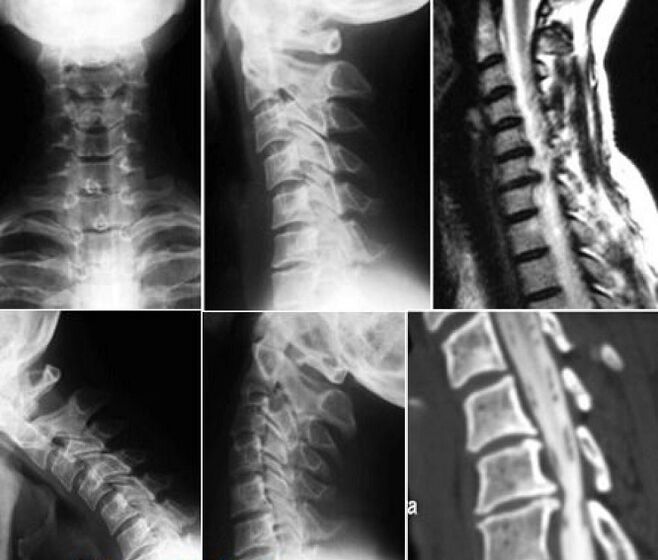Cervical osteochondrosis is typical of modern people due to an unhealthy lifestyle. Problems with nutritional deficiencies in brain tissue caused by them can lead to many complications, including fatal complications.
It is important to identify the development of the pathology over time. In the early stages, the treatment of cervical osteochondrosis is quite successful.
Signs and symptoms of disease
The cervical spine includes seven vertebrae. Each of them has its own function, but they all serve to support the movement of the head and neck.
The vertebrae are separated by special discs, the connective tissue of which is destroyed in osteochondrosis. This leads to a change in the location of the vertebrae, loss of spinal flexibility, compression of blood vessels and nerves. Due to the last pathology, the blood supply to the brain is interrupted.
Symptoms of the disease are associated with pressure on nerve endings and blood vessels. The main features are:
- Pain in the back of the neck and other parts of the head, dizziness.
- Cracks and "shivering" in the neck when moving the head.
- Painful sensations when raising arms.
- Numbness of the arms and neck, as well as the back muscles, their constant tension.
- Coordination problems.
- Bad dreams, insomnia.
- Nausea, tinnitus, vomiting.
- Mood swings.

With prolonged exposure to nerves and blood vessels, memory loss, concentration and speech problems can occur.
There are three stages of the disease, each with characteristic symptoms:
The sooner you find signs of an illness and the sooner you seek medical help, the easier and more effective the treatment will be.
Causes of disease
Cervical vertebrae are smaller and more fragile in size and structure than similar bones in other vertebral sections. Also, they are the most mobile. All of this leads to increased stress on the cervical spine and pathological transformation of the intervertebral discs. Under the influence of changes caused by osteochondrosis, small vessels and nerve roots are compressed.
Lack of movement during sedentary work always leads to metabolic failure and an increase in the level of salts in the lymph and blood. They accumulate in the cervical region. An unhealthy diet and being overweight will stimulate metabolic problems, and a lack of valuable vitamins and minerals will aggravate degenerative phenomena in connective tissues.
The main reasons for the development of pathological processes include:
- Hypodynamics.
- Staying in the same position for a long time (computer, driving).
- Salt deposits.
- Inadequate diet, leading to metabolic disorders.
- Lack of valuable vitamins and minerals.
- Excessive body weight.
- Injuries and chronic diseases of the musculoskeletal system.
- Regular hypothermia.
- Hormonal disturbances.
Most risk factors can be eliminated by changing one's lifestyle and balancing the body's metabolic processes.
What are the risks of problems with cerebral circulation?
One third of the nutrients enter the brain through the vertebral arteries. If they start to narrow and small vessels are pinched due to osteochondrosis, the brain tissue suffers from a deficiency of oxygen, as well as valuable trace elements and vitamins.
Why Brain Starvation Is Dangerous:
- Dysfunctions of the heart and blood vessels.
- Disorders of the musculoskeletal system (especially the shoulder body).
- Increased intracranial pressure.
- Micro-stroke and, subsequently, severe cerebral haemorrhages.
Neglected conditions can lead to encephalopathy - a dangerous disease that causes brain tissue dystrophy.
All of these pathological conditions can develop if you don't pay attention to early signs of osteochondrosis and vascular dysfunction. If the disease is diagnosed in the early stages, dangerous consequences can be avoided.
Visual and hardware diagnostics
To find out exactly the causes and stage of the disease, a comprehensive examination is performed:
An experienced doctor can make a preliminary diagnosis by watching how you walk and move your head.
Hardware studies of problematic organs are also mandatory. These include:
- Radiography.
- Doppler ultrasound.
- Rheoencephalography and angiography of cerebral vessels.
- Computed tomography or magnetic resonance imaging.
- Electrocardiography.

The results will help identify damaged discs, clarify the degree of damage to blood vessels, spinal tissues and brain. When a diagnosis is made, treatment begins immediately.
Drug and non-drug treatment
If the course of the disease is accompanied by severe pain and swelling, they must be removed first. For this, use analgesics or massage the cervical region with anesthetic medication.
Sometimes doctors recommend using an applicator that not only relieves pain but also relieves spasms. Pepper patches can help reduce pain in some cases. The swelling is eliminated with the help of diuretics.

Additional therapy for the disease can be divided into two areas: the treatment of osteochondrosis by restoring the spine and improving blood circulation in brain tissues and neuronal metabolism.
Osteochondrosis will take some time. To restore spinal health, drug and non-drug therapy is used.
The latter includes:
- Corrective gymnastics.
- The help of a masseuse.
- Proper nutrition.
- Acupuncture.
- Physiotherapy.
The best physical therapy techniques include electrophoresis and magnetotherapy. The first type of procedure helps relieve muscle spasms, the second - dilates blood vessels and improves intercellular metabolism.
With osteochondrosis, smoked meats, fried foods, fast food, carbonated drinks are not recommended. Chicken and rabbit meat, cooked fish, vegetables and fruits, herbs are considered healthy products.
In addition to anti-inflammatories and analgesics, chondroprotectors are used to restore the spine - agents that renew the cartilage tissue of the intervertebral discs. If abnormal muscle tension is observed, muscle relaxants can be used.
To improve blood flow to the brain and neuronal metabolism, the doctor also prescribes medication. These include:

In addition, doctors recommend vitamin and mineral complexes to restore the body weakened by the disease.
Only a specialist can prescribe medications and medical procedures. Self-medication is unacceptable and deadly.
Prevention: how to prevent disease
The causes of violations lie precisely in unhealthy habits. To avoid unpleasant consequences, you must:
In one day, rarely can anyone change their life in the right direction, the transition must be done gradually.
Medical assistance is needed at the first signs of cervical osteochondrosis. Timely measures will avoid serious consequences.

























